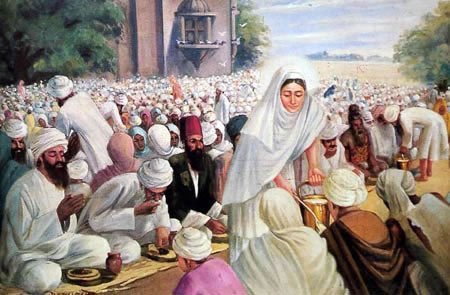Sikhism laid its foundation on the grounds of equality and held it as the governing principle in the way people led their lives and treated one another. It was also ascribed that men and women should live as equals, which was materialised with women shouldering leadership as well as service. History remembers the great Sikh warriors, Sewadars (volunteers providing selfless service) and the propagators of the teachings of Sikhism, however, it largely remembers the men.
By principle she preached equality and pursued women to lead a life that was independent.
On the contrast, Sikh women also took the same share of going on battles, delivering services and teachings. The women too acted as the backbone of Sikhism and shared the same responsibilities and roles as the men. Mata Khivi was one such woman who took it on her self to address the values of Sikhism. She strengthened the Langar System (free kitchen) and played an instrumental role in organising it.
Langar system or free community kitchen is tradition associated with Sikh faith in serving people irrespective of their socio-economic status. The intention behind this system was to propagate the idea of equality where food is served to all in one place without any discrimination on the basis of caste, color, religion, gender or class. The Langar system was initiated by the first Guru of Sikhism, Guru Nanak Dev. This tradition was later nurtured by Mata Khivi who with her selfless service towards the community served the pilgrims and the visitors .
Mata Khivi was born in 1506 in Sanghar, the province of Sindh, now in Pakisthan to Karan Devi and Bhai Devi Chand Khatri. At age of 13 Mata Khivi was married to Lahina. While Lahina was preaching Guru Nanak, he soon gained his trust as a devoted disciple. This led to him becoming the second Guru of Sikhs, Guru Angad.
She embodied the spirit of collective good and social commitment in 16th century Punjab
It is said that Mata Khivi was subjected to criticism because she was planning to follow Sikhism. However, it is also said that she did this with complete knowledge and her decision was not governed by her husband’s choice.
Mata Khivi led a very compassionate life, she gave birth to four children and at the same time devoted herself as a sewadar. She continued to organise and manage the Langar during Guru Amar Das’ time, and did Seva until Guru Arjun Dev’s time, the Langar soon came to be known as “Khivi ka Langar”. By principle she preached equality and pursued women to lead a life that was independent. Apart from organising the Langar, she played an important role in spreading the teachings of Sikhism.
Also read: Meet Rajkumari Amrit Kaur: India’s First Health Minister | #IndianWomenInHistory
Mata Khivi is remembered as the woman who upheld humanity above all other virtues and prejudices. She is the only one of Guru’s wives whose name has been mentioned in the Guru Granth Sahib. She has been described as a “good person”, “an affectionate mother” and as “one who provides shelter and protection to others.”
Also read: 5 Sikh Women In History You Should Know About
Mata Khivi lived for 30 years after Guru Angad’s death and during that period continued to the serve the community relentlessly. She embodied the spirit of collective good and social commitment in 16th century Punjab and possibly one of the first few women of that era who stepped out of their house to work.
References
Author’s note: Very little information was available about Mata Khivi, which made compilation of her life history and works difficult. If there are any sources you know of, let us know in the comments section.
About the author(s)
Simran is a student at University of Delhi. She is all about butter chicken, books and equality.




